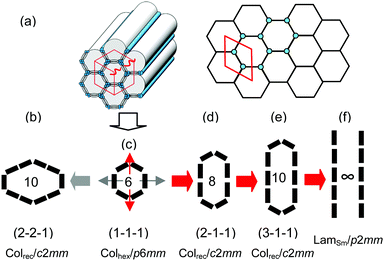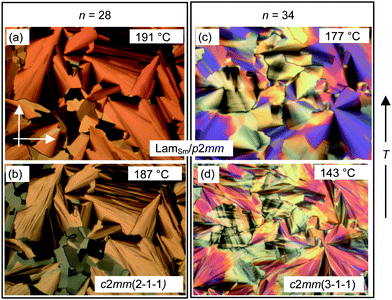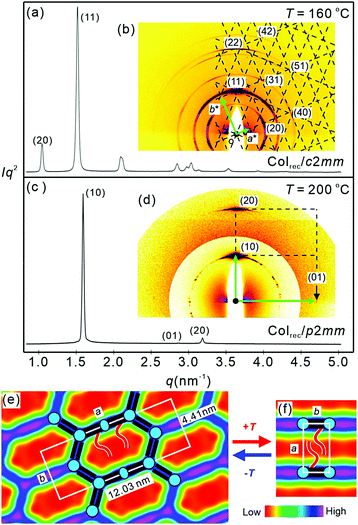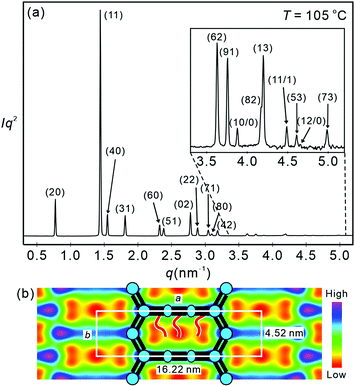A self-assembled liquid crystal honeycomb of highly stretched (3-1-1)-hexagons†
Alexander
Scholte
a,
Sebastian
Hauche
a,
Matthias
Wagner
a,
Marko
Prehm
a,
Silvio
Poppe
a,
Changlong
Chen
b,
Feng
Liu
 *b,
Xiangbing
Zeng
*b,
Xiangbing
Zeng
 c,
Goran
Ungar
c,
Goran
Ungar
 *bc and
Carsten
Tschierske
*bc and
Carsten
Tschierske
 *a
*a
aInstitute of Chemistry, Martin Luther University Halle-Wittenberg, Kurt-Mothes-Straße 2, 06120 Halle, Germany. E-mail: carsten.tschierske@chemie.uni-halle.de
bState Key Laboratory for Mechanical Behaviour of Materials, Shaanxi International Research Center for Soft Matter, Xi’an Jiaotong University, Xi’an 710049, P. R. China. E-mail: feng.liu@xjtu.edu.cn
cDepartment of Materials Science and Engineering, University of Sheffield, Sheffield S1 3JD, UK. E-mail: g.ungar@sheffield.ac.uk
First published on 25th November 2019
Abstract
A new liquid crystalline honeycomb phase is reported, containing highly stretched giant hexagonal cells with two opposing walls spanned by three consecutive end-to-end H-bonded rods, the (3-1-1) hexagons.
Since ancient times tiling patterns have fascinated scientists and artists alike.1 Regular hexagons allow periodic tiling with the largest tile area at minimal circumference. This has been long known to bees,2 but was mathematically proven only recently.3 Hexagonal tilings are also observed most often in self-assembly of molecules in nets on solid surfaces,4,5 in metal-organic6 or covalent-organic frameworks7,8 and in liquid crystalline (LC) honeycombs formed by T-/X-shaped polyphilic molecules.9–12 In these polyphilic compounds a rod-like unit has two sticky ends provided by hydrogen-bonding glycerol groups. The cooperative and dynamic hydrogen bonds connect the rods end-to-end and side-by-side, thus forming walls of parallel arranged rods (Fig. 1a). The columns of hydrogen-bonded glycerols at the edges fuse these walls to a self-assembled honeycomb and the flexible and lipophilic lateral chains fill the space inside the polygonal prismatic cells. As the rod-like units have fixed length, increasing the chain volume changes the number of molecules in the circumference of the prismatic cells; thus triangular give way to square and pentagonal and eventually to hexagonal LC honeycombs.9,13 A unique feature of these fluid self-assembled honeycombs is the emergence of giant honeycombs with some walls formed by dimers of end-to-end connected rods if the lateral chain volume is further increased.10a,14,15 For biphenyl-based T-shaped bolapolyphiles two types of such monohedral giant honeycombs are known so far, being derived from the regular hexagonal honeycomb (Fig. 1a and c) by stretching the hexagonal cells in different directions (Fig. 1b and d). These honeycombs can be described as (m-n-p)-hexagons, where m, n, p are the numbers of end-to-end linked rod-like units forming the three opposing sides of the hexagon.
 | ||
| Fig. 1 (a) Hexagonal honeycomb and (b–e) cross sections through one honeycomb cell of (c) the regular hexagonal and (b, d, e) the stretched hexagonal cells with the LC phase types and the corresponding crystallographic 2d lattices; (f) shows the lamellar phase (LamSm) formed by T-shaped bolapolyphiles.10,14,15 | ||
The largest among them, yet known, is the (2-2-1) honeycomb being stretched along the normal of two opposite sides of the regular hexagonal cells and involving 10 molecules in the circumference with four of the six sides being two molecules long (Fig. 1b).15 The (2-1-1) hexagon obtained by stretching along the diagonal has only two sides with double length and thus contains only 8 molecules (Fig. 1d).10a,14 In both cases the hexagonal p6mm symmetry is reduced to centred rectangular c2mm. In all reported cases these stretched hexagons are followed by lamellar phases (Lam) upon further side-chain elongation or with rising temperature (Fig. 1f). In these lamellar phases the rod-like units lie parallel to the layers and can assume in-plane orientational and positional long range order.16 This leads to a variety of different Lam phases, also including those with positional correlation between the layers. Depending on the mode of layer coupling, this correlation results in c2mm, p2 or p2mm 2D lattices; the latter is shown in Fig. 1f.17
Herein we report the first self-assembled tiling pattern involving end-to-end-connected triplets of molecular rods. There are 10 molecules in each cell circumference of this new stretched hexagonal LC honeycomb, which can be described as tiling by elongated (3-1-1) hexagons (Fig. 1e).
For this purpose the series of T-shaped bolapolyphiles 1/22–1/34 was synthesized by a sequence of Suzuki Miyaura cross-coupling reactions as key steps (Scheme S1, ESI†);18 for details of synthesis and investigation methods see the ESI.† The phase types, phase transitions and lattice parameters of the LC phases formed by these compounds are collated in Table 1. Four distinct enantiotropic (thermodynamically stable) LC phases were observed for compounds 1/22–1/34. In all of them the wide angle X-ray scattering is completely diffuse with a maximum at d ∼ 0.46–0.47 nm (see Fig. S3b, S6e, S11b, S13b, S17b, d, ESI†), indicating that the individual molecules do not have fixed positions, i.e. the molecules are in a liquid-like state, as also evident by the easy flow under slight mechanical forces. The birefringent optical textures observed between crossed polarizers confirm the LC state. They are very similar for all compounds, 1/24–1/34, showing spherulitic and fan-like textures as typical for LC phases with a 2d lattice (see Fig. 2 and Fig. S4, S9, S18, ESI†).
| 1/n | Phase transitions T/°C [ΔH/kJ mol−1] | Colhex/p6mm | Colrec/c2mm | LamSm/p2mm |
|---|---|---|---|---|
| a/nm (T/°C) | a, b/nm (T/°C) | a, b/nm (T/°C) | ||
| a Data were taken from the first DSC cooling scans at 10 K min−1 (peak temperatures). Abbreviations: Cr = solid crystalline state, Iso = isotropic liquid state; Colhex/p6mm(1-1-1) = hexagonal columnar LC phase (regular hexagonal honeycomb, Fig. 1a and c); Colrec/c2mm(2-1-1) = rectangular columnar LC phase with c2mm plane group representing a honeycomb composed of (2-1-1)-hexagons (see Fig. 1d); Colrec/c2mm(3-1-1) = c2mm phase composed of (3-1-1)-hexagons (see Fig. 1e); LamSm/p2mm = lamellar phase with p-terphenyl cores arranged in the layer plane; and long range AA-correlation of the in-plane periodicities in adjacent layers on a p2mm lattice (Fig. 1f); for phase transitions on heating see Table S1 (ESI) and for additional structural data, see Table S13 (ESI); for the DSC traces, see Fig. S2, S5, S7, S10, S12, S14 and S16 (ESI). | ||||
| 1/22 | Iso 197 [10.3] Colhex/p6mm(1-1-1) 54 [20.6] Cr | 4.37 (150) | — | — |
| 1/24 | Iso 193 [6.2] LamSm/p2mm 184 [1.6] Colrec/c2mm(2-1-1) 59 [22.3] Cr | — | 12.19; 4.40 (185) | 4.11; 2.19 (195) |
| 1/26 | Iso 198 [6.6] LamSm/p2mm 187 [7.5] Colrec/c2mm(2-1-1) 60 [21.7] Cr | — | 12.02; 4.41 (170) | 3.91; 2.20 (200) |
| 1/28 | Iso 203 [7.2] LamSm/p2mm 189 [2.4] Colrec/c2mm(2-1-1) 62 [27.0] Cr | — | 12.03; 4.41 (160) | 3.95; 2.19 (200) |
| 1/30 | Iso 196 [7.1] LamSm/p2mm 174 [2.5] Colrec/c2mm(2-1-1) 64 [30.2] Cr | — | 11.80; 4.45 (160) | n.d. |
| 1/32 | Iso 201 [8.0] LamSm/p2mm 164 [2.7] Colrec/c2mm(2-1-1) 70 [32.3] Cr | — | 11.80; 4.52 (105) | 4.06; 2.18 (170) |
| 1/34 | Iso 200 [7.8] LamSm/p2mm 150 [2.4] Colrec/c2mm(3-1-1) 71 [29.7] Cr | — | 16.22; 4.52 (105) | 4.18; 2.18 (165) |
 | ||
| Fig. 2 Optical textures (a and b) of 1/28, and (c and d) of 1/34, in the LC phases at the indicated temperatures; the directions of the polarizers is shown in (a); for additional textures of 1/28, see Fig. S9, ESI† and for textures of 1/34 with additional λ-retarder plate, see Fig. S18, ESI.† | ||
The symmetry of the 2d lattice was determined by XRD investigations. Compound 1/22 with the shortest chain forms a hexagonal columnar LC phase with p6mm plane group and a lattice parameter ahex = 4.37 nm representing a regular hexagonal (1-1-1)-honeycomb (for details see Fig. S1–S3, ESI†). The effective length of the bolaamphiphilic unit of compounds 1/n between the ends of the glycerol units (Lmol) in this self-assembled LC structure can thus be estimated according to Lmol = ahex/√3 ∼ 2.5 nm, which is in good agreement with the values obtained with molecular models (Lmin = 2.3 nm; Lmax = 2.6 nm, see Fig. S19, ESI†).18
The subsequent even numbered homologues 1/24–1/32 form two LC phases with 2D lattice, which are described in more detail for compound 1/28 as representative example (for additional data and the other compounds, see Fig. S4–S15 (ESI†) and Tables S1–S10 and S13, ESI†). The transition between the two LC phases at T = 189 °C is associated with a DSC peak (ΔH = 2.4 kJ mol−1, see Fig. S10, ESI†). At the same time the fans in the optical texture become broken with a slight decrease in birefringence – note the change in colour of the fans in Fig. 2a and b (see also Fig. S9b–d, ESI†). The SAXS pattern changes at this temperature too. The scattering pattern below 189 °C can be indexed to a centred rectangular lattice with c2mm plane group (Fig. 3a and Fig. S11a, ESI†), which was confirmed by the 2D-GISAXS pattern of an aligned sample (Fig. 3b). The parameter a = 12.03 nm corresponds to ∼5 times Lmol; the parameter b = 4.41 nm is close to √3Lmol. Based on these data and considering the reconstructed electron density (ED) map (Fig. 3e, for details of the ED reconstruction, see ESI†) it can be concluded that a (2-1-1)-hexagonal honeycomb is formed, with two sides of the hexagon formed by end-to-end molecular pairs and four sides only one molecule long; on average about two molecules are organized laterally back-to-back in each of the honeycomb walls (see Table S13, ESI†).10a,14
 | ||
| Fig. 3 Compound 1/28: (a) SAXS diffractogram (for the full indexations see Fig. S11a, ESI†) and (b) GISAXS pattern of the Colrec/c2mm(2-1-1) phase at 160 °C, superimposed are reciprocal lattices for two observed orientations; (c) SAXS diffractogram (see also Fig. S11c, ESI†) and (d) GISAXS pattern of the LamSm/p2mm phase at 200 °C; (the outer part of the pattern is enhanced); (e) and (f) the ED map of the Colrec/c2mm(2-1-1) phase and the LamSm/p2mm phase with overlaid model, (see also Fig. S9–S11 and Tables S6, S7 and S13, ESI†). | ||
The X-ray diffractogram of the LC phase above 189 °C (Fig. 3c) is dominated by a strong Bragg peak, corresponding to a spacing of d = 3.95 nm, and its second order (10 and 20) on the meridian of the 2D GISAXS pattern, indicating a lamellar phase. An additional very weak peak on the equator is indexed as (01) of a non-centred rectangular lattice with plane group p2mm (Fig. 3d). The parameter b = 2.19 nm of this rectangular lattice is close to the smallest possible molecular length (Lmin = 2.3 nm), thus indicating an in-plane periodicity corresponding to the molecular length.‡17 These data are in agreement with an AA-correlated LamSm phase, where the rod-like units are aligned parallel to the layer planes and the fluid alkyl chains fill the space between the layers (Fig. 1f).16,17 The phase structure is in line with the ED map in Fig. 3f, showing a weakly modulated lamellar phase; the high ED (purple) regions are attributed to layers containing the bolaamphiphilic cores (terphenyls + glycerols) and the low ED regions to layers containing alkyl chains. Note the change in orientation upon the Colrec/c2mm–LamSm/p2mm transition – while the (2-1-1) honeycomb lies tilted on its most densely packed plane {110} on the horizontal Si substrate (Fig. 3b and e), the structure turns to lie horizontally on the densest plane of the lamellar phase, i.e. the {010} (Fig. 3d and f).
Compound 1/34 with the longest chains forms two LC phases, a LamSm/p2mm at high temperature and a Colrec/c2mm phase at low temperature (Table 1). The optical textures (Fig. 2c and d) are similar to those of compound 1/28 (Fig. 2a and b). The parameter b of the c2mm phase remains almost the same as in compounds 1/24 to 1/32 (see Table 1 and diffraction pattern in Fig. 4a). However, the parameter a = 16.22 nm of the c2mm lattice is about one third larger, now corresponding to 6–7 times Lmol and thus indicating an extension of the long sides of the stretched hexagons from two to three molecular lengths. This indicates that a (3-1-1)-honeycomb is formed (Fig. 1e). The proposed (3-1-1)-structure of the honeycomb is corroborated by the ED map reconstructed from the SAXS pattern (Fig. 4b). This shows the elongated low ED aliphatic interior of the prismatic cells (red) separated by high ED walls of the stretched hexagonal cells containing the p-terphenyl cores and the glycerol groups (blue/purple). The formation of this unique honeycomb with 10 molecules in the circumference is obviously required by the large volume of the lateral alkyl chain exceeding the space available in the smaller 8-molecule (2-1-1) hexagons. Moreover, the contribution of linear all-trans segments supports a parallel organization of the long linear n-alkyl chains, favouring the more stretched (3-1-1)-cells. The less stretched (2-2-1) alternative was found in the shorter biphenyl-based bolapolyphiles with much bulkier branched and semiperfluorinated lateral chains.15
 | ||
| Fig. 4 Compound 1/34: (a) SAXS diffractogram; (b) corresponding ED map with overlaid model of the Colrec/c2mm (3-1-1) phase at 105 °C; see also Fig. S16–S18 and Tables S11–S13 (ESI†). | ||
With rising temperature and further chain expansion the (3-1-1) honeycombs burst open forming infinite layers (LamSm/p2mm). The remaining in-plane periodicity between the glycerol columns means that we still have a rectangular 2D lattice, this time p2mm, with almost the same parameters as found for compounds 1/24–1/32 (see Table 1, for XRD, see Fig. S17, ESI†). The higher birefringence of the lamellar p2mm phase compared to that of the honeycomb (Fig. 2b and c), is consistent with all terphenyls being aligned along the layers (b direction) in the Lamsm phase compared with the c2mm honeycomb where some molecules are inclined.
In summary, a new LC phase formed by a giant honeycomb with highly deformed hexagonal (3-1-1) cells is reported. It is considered as an intermediate structure at the transition from hexagonal (1-1-1) honeycombs to lamellar self-assembly (Fig. 1). It evolves in the sequence (1-1-1)–(2-1-1)–(3-1-1) with growing length of a linear n-alkyl chain. This raises the question if even larger (m-1-1)-honeycombs could be stable under certain conditions. More generally, the (3-1-1) hexagonal cell provides a new binodal tiling motif.§ This has not been observed previously in any other self-assembled system, either in nets on solid surfaces,4,5 representing 2d analogues of the LC honeycombs, or in their solid analogues, the covalent and metal–organic frameworks (COFs and MOFs).6,7 The new phase expands the amazing zoo of self-assembled LC super-structures achieved by proper design of polyphilic molecules based on the simple p-terphenyl core unit.10b,c,11,18–20 Thus, this work contributes to the fundamentals of development of complexity in fluids by using a well designed minimalistic model system.
This work is supported by the DFG (392435074), EPSRC (EP-K034308, EP-P002250), the NSFC (No. 21761132033, 21374086) and Science and Technology Agency of Shaanxi Province (2016KW-050 and 2018KWZ-03). The authors thank for the support by 111 Project 2.0 (BP2018008) and Shanghai Synchrotron Radiation Facility (beamline BL16B1) and Diamond Light Source (beamline I22) for providing synchrotron beamtime and help with the XRD experiments.
Conflicts of interest
There are no conflicts to declare.Notes and references
- B. Grünbaum and G. Shephard, Tilings and patterns, WH Freeman, New York, 1987 Search PubMed.
- F. Toth, Bull. Am. Math. Soc., 1964, 70, 468–481 CrossRef.
- T. C. Hales, Disc. Comput. Geom., 2001, 25, 1–22 CrossRef.
- K. S. Mali, N. Pearce, S. De Feyter and N. R. Champness, Chem. Soc. Rev., 2017, 46, 2520–2542 RSC.
- J. I. Urgel, D. Écija, G. Lyu, R. Zhang, C. A. Palma, W. Auwärter, N. Lin and J. V. Barth, Nat. Chem., 2016, 8, 657–662 CrossRef CAS PubMed.
- J. Jiang, Y. Zhao and O. M. Yaghi, J. Am. Chem. Soc., 2016, 138, 3255–3265 CrossRef CAS PubMed.
- N. Huang, P. Wang and D. Jiang, Nat. Rev. Mater., 2016, 1, 16068 CrossRef CAS.
- X. Zhuang, W. Zhao, F. Zhang, Y. Cao, F. Liu and X. Feng, Polym. Chem., 2016, 7, 4176–4181 RSC.
- C. Tschierske, Chem. Soc. Rev., 2007, 36, 1930–1970 RSC; C. Tschierske, C. Nürnberger, H. Ebert, B. Glettner, M. Prehm, F. Liu, X. B. Zeng and G. Ungar, Interface Focus, 2012, 2, 669–680 CrossRef CAS PubMed.
- (a) X. H. Cheng, M. Prehm, M. K. Das, J. Kain, U. Baumeister, S. Diele, D. Leine, A. Blume and C. Tschierske, J. Am. Chem. Soc., 2003, 125, 10977–10996 CrossRef CAS; (b) B. Chen, X. Zeng, U. Baumeister, G. Ungar and C. Tschierske, Science, 2005, 307, 96–99 CrossRef CAS PubMed; (c) S. Poppe, A. Lehmann, A. Scholte, M. Prehm, X. Zeng, G. Ungar and C. Tschierske, Nat. Commun., 2015, 6, 8637 CrossRef CAS PubMed.
- C. Tschierske, Angew. Chem., Int. Ed., 2013, 52, 8828–8878 CrossRef CAS.
- F. Liu, R. Kieffer, X. Zeng, K. Pelz, M. Prehm, G. Ungar and C. Tschierske, Nat. Commun., 2012, 3, 1104 CrossRef PubMed.
- Simulation work: A. J. Crane, F. J. Martinez-Veracoechea, F. A. Escobedo and E. A. Muller, Soft Matter, 2008, 4, 1820–1829 RSC; M. A. Bates and M. Walker, Soft Matter, 2009, 5, 346–353 RSC; X. Liu, K. Yang and H. Guo, J. Phys. Chem. B, 2013, 117, 9106–9120 CrossRef CAS.
- M. Prehm, C. Enders, M. Y. Anzahaee, B. Glettner, U. Baumeister and C. Tschierske, Chem. – Eur. J., 2008, 14, 6352–6368 CrossRef CAS.
- M. Prehm, F. Liu, U. Baumeister, X. Zeng, G. Ungar and C. Tschierske, Angew. Chem., Int. Ed., 2007, 46, 7972–7975 CrossRef CAS PubMed.
- (a) M. Prehm, X. H. Cheng, S. Diele, M. K. Das and C. Tschierske, J. Am. Chem. Soc., 2002, 124, 12072–12073 CrossRef CAS; (b) N. M. Patel, I. M. Syed, C. Rosenblatt, M. Prehm and C. Tschierske, Liq. Cryst., 2005, 32, 55–61 CrossRef CAS.
- M. Prehm, C. Enders, X. Mang, X. Zeng, F. Liu, G. Ungar, U. Baumeister and C. Tschierske, Chem. – Eur. J., 2018, 24, 16072–16084 CrossRef CAS.
- A. Lehmann, M. Prehm, C. Chen, F. Liu, X. Zeng, G. Ungar and C. Tschierske, Chem. Commun., 2018, 54, 12306–12309 RSC.
- (a) R. Kieffer, M. Prehm, B. Glettner, K. Pelz, U. Baumeister, F. Liu, X. Zeng, G. Ungar and C. Tschierske, Chem. Commun., 2008, 3861–3863 RSC; (b) M. Prehm, F. Liu, X. B. Zeng, G. Ungar and C. Tschierske, J. Am. Chem. Soc., 2008, 130, 14922–14923 CrossRef CAS PubMed; (c) S. Poppe, C. Chen, F. Liu and C. Tschierske, Chem. Commun., 2018, 54, 11196–11199 RSC; (d) A. Lehmann, A. Scholte, M. Prehm, F. Liu, X. Zeng, G. Ungar and C. Tschierske, Adv. Funct. Mater., 2018, 28, 1804162 CrossRef; (e) X. Zeng, S. Poppe, A. Lehmann, M. Prehm, C. Chen, F. Liu, H. Lu, G. Ungar and C. Tschierske, Angew. Chem., Int. Ed., 2019, 58, 7375–7379 CrossRef CAS.
- (a) F. Liu, B. Chen, B. Glettner, M. Prehm, M. K. Das, U. Baumeister, X. Zeng, G. Ungar and C. Tschierske, J. Am. Chem. Soc., 2008, 130, 9666–9667 CrossRef CAS PubMed; (b) F. Liu, B. Chen, U. Baumeister, X. B. Zeng, G. Ungar and C. Tschierske, J. Am. Chem. Soc., 2007, 129, 9578–9579 CrossRef CAS; (c) B. Chen, X. Zeng, U. Baumeister, S. Diele, G. Ungar and C. Tschierske, Angew. Chem., Int. Ed., 2004, 43, 4621–4625 CrossRef CAS PubMed; (d) B. Chen, U. Baumeister, G. Pelzl, M. K. Das, X. Zeng, G. Ungar and C. Tschierske, J. Am. Chem. Soc., 2005, 127, 16578–16591 CrossRef CAS PubMed.
Footnotes |
| † Electronic supplementary information (ESI) available: Methods, syntheses, analytical data, additional XRD and structural data. See DOI: 10.1039/c9cc08502e |
| ‡ Though there is no indication of a uniform tilt of the molecules it cannot be rigorously excluded. However, it is more likely that a reduced orientational order parameter of the terphenyl rods in the layers could contribute to the slight reduction of the effective molecular length. |
| § This tiling is considered as binodal, as there are two types of nodes forming this stretched hexagonal net, the three-fold junctions connecting the walls at the vertices and the two-fold junctions within the larger walls fusing the terphenyls of the expanded walls. |
| This journal is © The Royal Society of Chemistry 2020 |

